In this blog, the best way on how to train a dog who is aggressive. I'll be sharing the strategies that worked for more than 100,000 dog owners with dog dominance aggression.
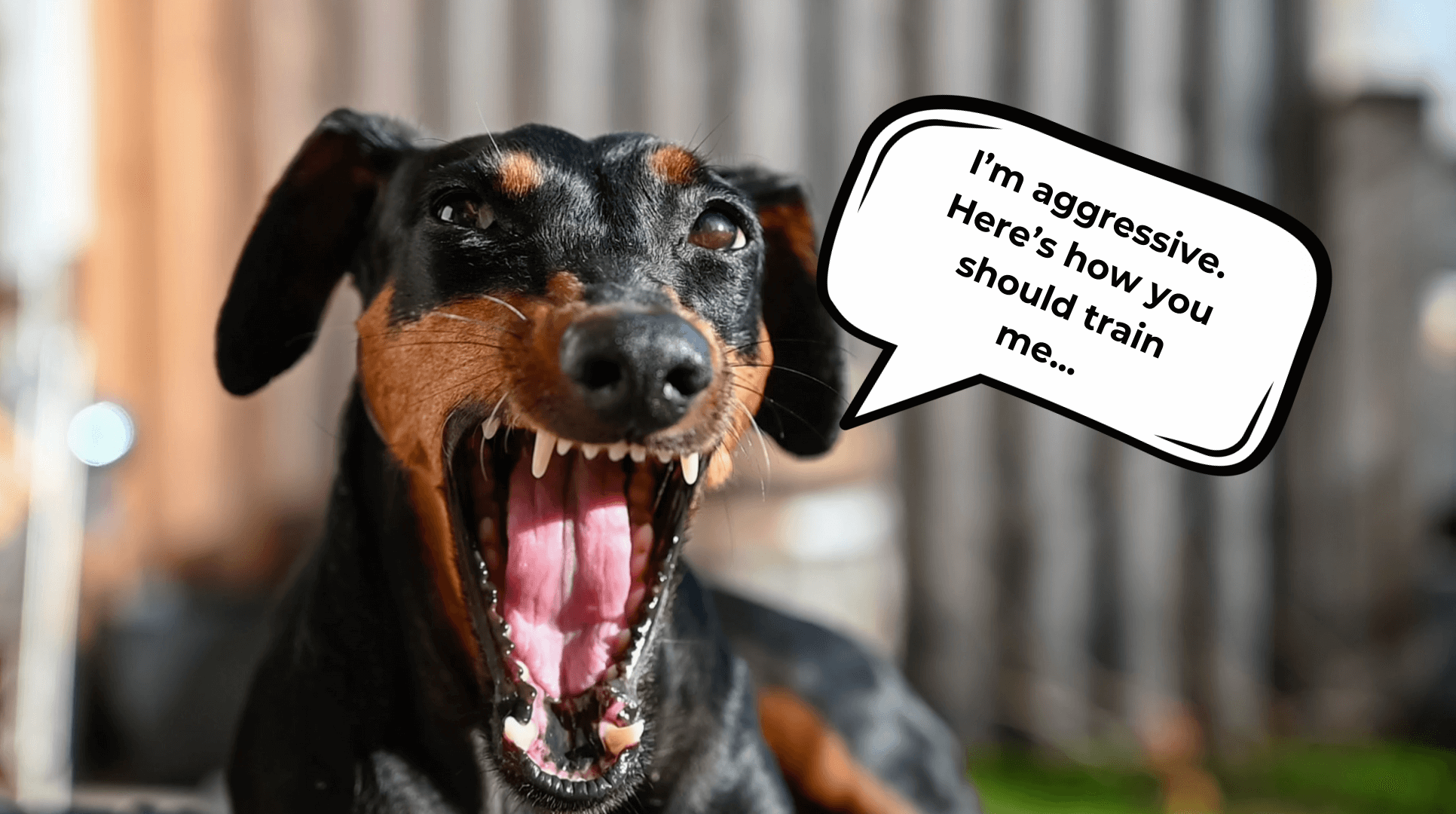
Over the years as a professional dog trainer, I've worked with thousands of unruly and aggressive dogs who react aggressively to other dogs.
I've learned a good amount of insight on understanding dog-dog aggression.
One encounter that sticks in my memory is a Great Dane Border Collie cross, who weighed close to 80 kg and was so aggressive that when I brought him out of the car on a double leash my dogs hid in the bushes on the far side of the park.
On the other end of the spectrum I've also seen tiny little dogs snap away at my biggest dog Jack whilst he calmly ignored them and carried on smelling the flowers!
And from these experiences, I've learned that size, breed, dog's personality, color, etc., tend to have nothing to do with why a dog is aggressive.
With that in mind, I know that when working with an aggressive dog, I have to answer a few questions…
‘Why did they do what they did?'
‘What was the goal of their aggression?'
‘What made them do it?'
“If my dog acts aggressive, should I give up on them?”
If we can answer those questions then we get a better understand of where a dog is coming from and then form an approach that will help them start to relax and overcome their aggression.
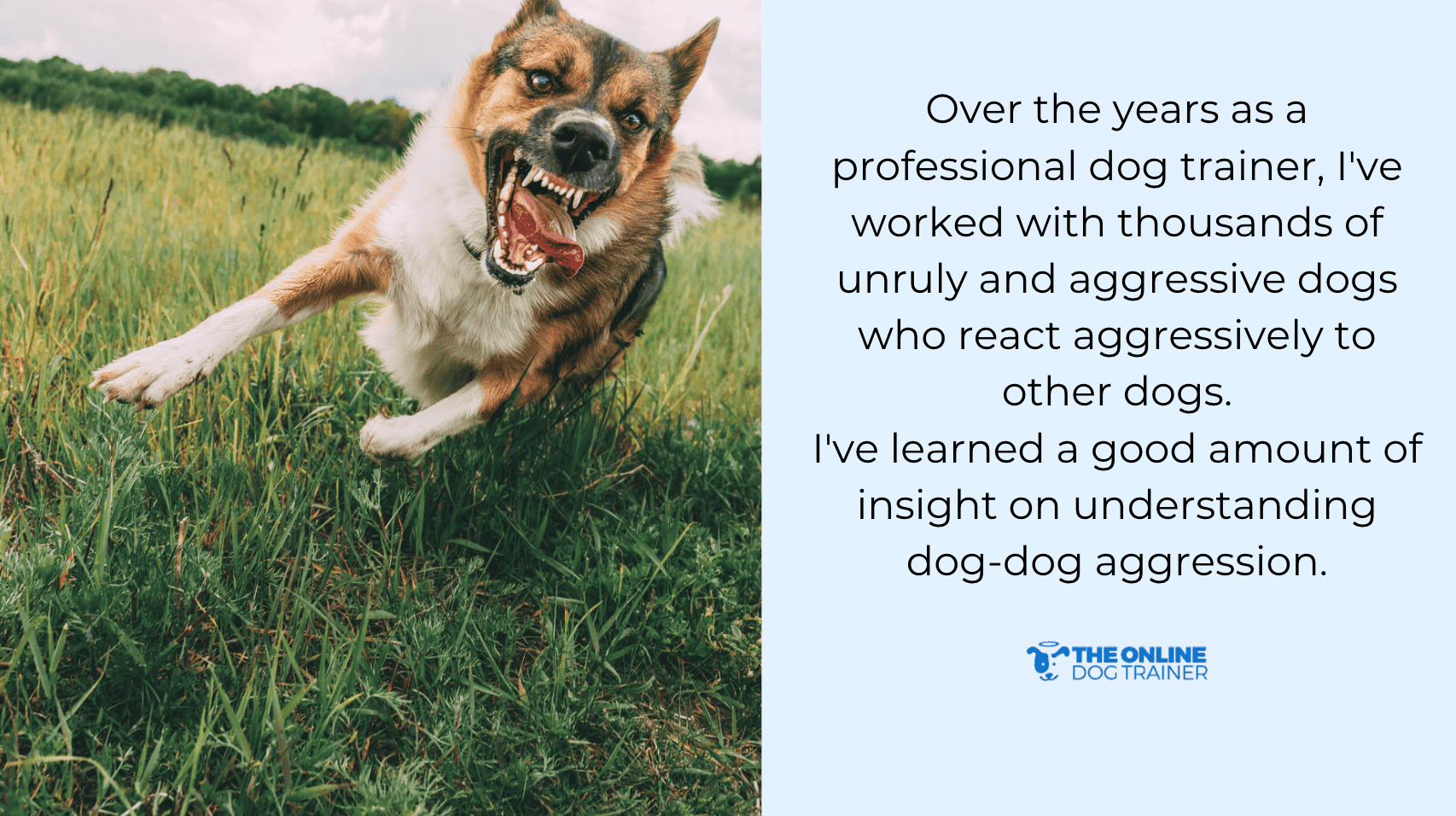
Now clearly, there are many different reasons why a dog may be aggressive. They may have a fear of something happening, their aggression may be linked to some previous abuse, they may feel threatened, be protecting something or somebody or simply have a serious lack of confidence.
If I tried to go into all of those problems, we'd be here for days.
So, today my focus is going to be on how to better understand the difference between dominant and fearful aggression– two of the most common types of aggression and then you'll be able to get an idea of what you can do to help them.
Let's start.
Key Takeaways
- Fear aggression isn't always from past abuse; it can stem from perceived threats or innate fears.
- Both fear and dominance aggression are best managed by establishing calm, consistent leadership.
- Effective strategies include identifying triggers, understanding dog body language, and using positive reinforcement.
Table of Contents
Fear-Based Aggression in Dogs
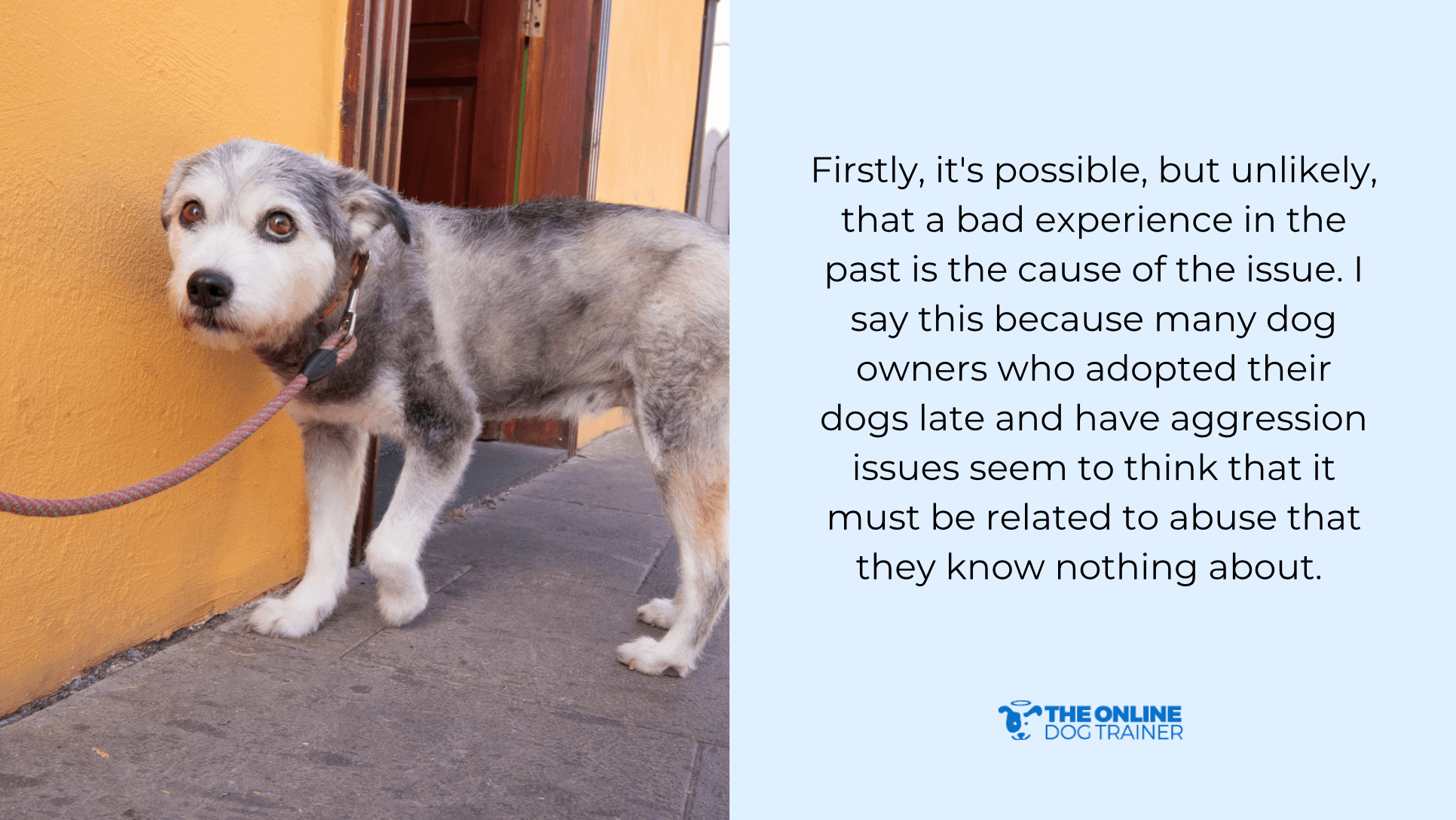
There is a saying that there is only love and fear, and with fear based aggression this is certainly true!
So, let's take a look at what fear-based aggression actually means and what may have caused it!
What is Protective Aggression Due to Fear?
Firstly, it's possible, but unlikely, that a bad experience in the past is the cause of the issue.
I say this because many dog owners who adopted their dogs late and have aggression issues seem to think that it must be related to abuse that they know nothing about. Although not all dogs who have been rescued or adopted will show aggression, some do. And when aggression manifests, owners immediately associate it with past experiences.
However not only does this rarely makes sense but it also leaves them feeling helpless to solve the problem (and I'd like to suggest that there is hope)!
On further questioning they confirm that for the first few months during which they had their dog the dog was fine socialising and playing happily.
So why does fear-based aggression come out of nowhere?
FREE REACTIVITY WEBINAR GUARANTEED TO SOLVE AGGRESSION IN JUST DAYS!Factors for Fear-based Aggression
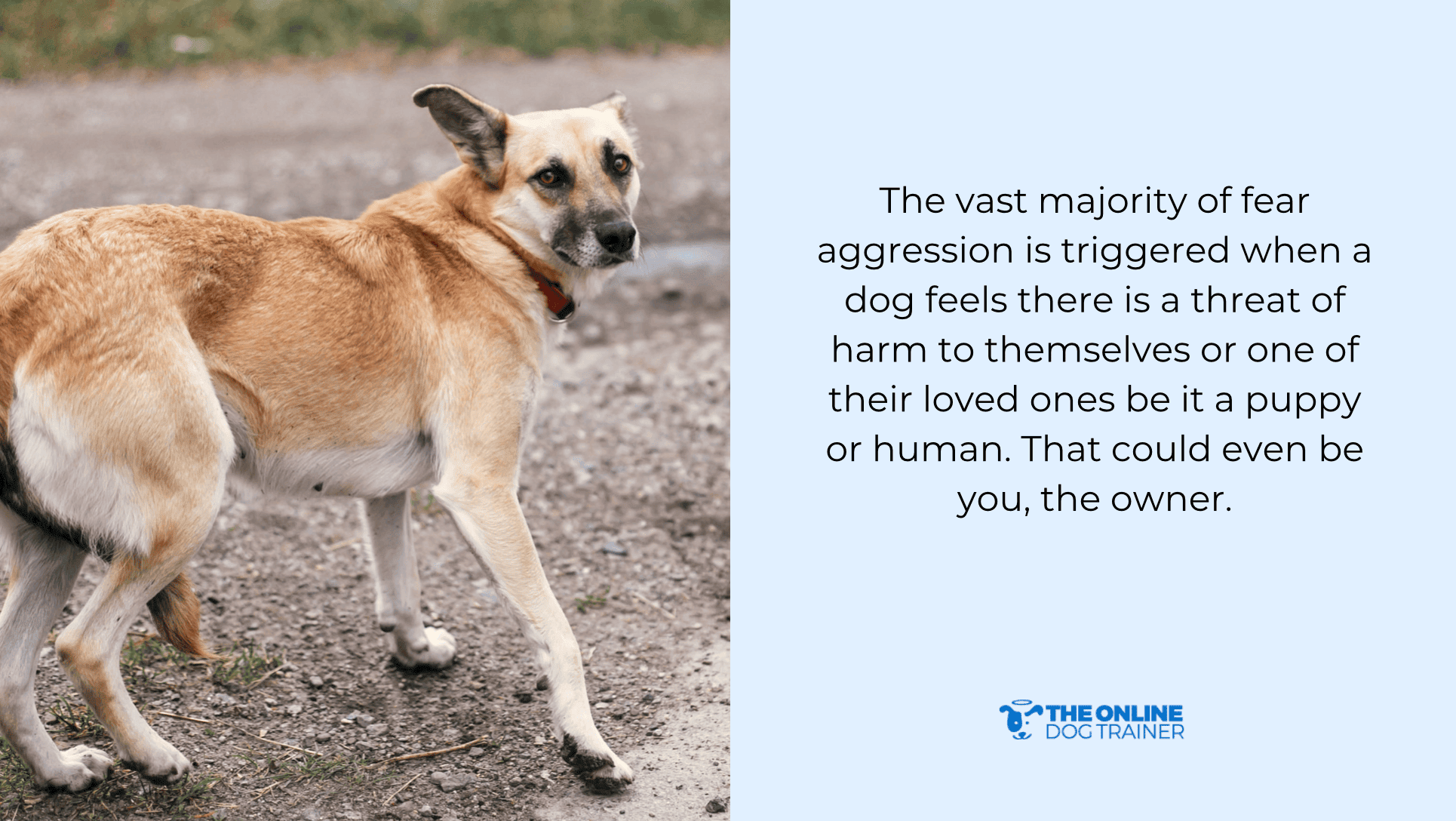
#1: Threat and Harm
The vast majority of fear aggression is triggered when a dog feels there is a threat of harm to themselves or one of their loved ones.
Common triggers are other dogs, strangers, and weird sounds and scents. If your dog is a rescue dog, they can be prone to triggers if they've been mistreated in the past.
So, if your loyal companion feels you're in harm's way, this aggressive fear-based behavior can come out of nowhere to protect you.
Now, a simple indicator that this could be the case is if your dog only reacts like this when you are with them. If your dog is aggressive to other dogs when you walk them, but they'll walk and play happily at the dog park when other people take them, your dog can be highly protective of you.
#2: Reactivity
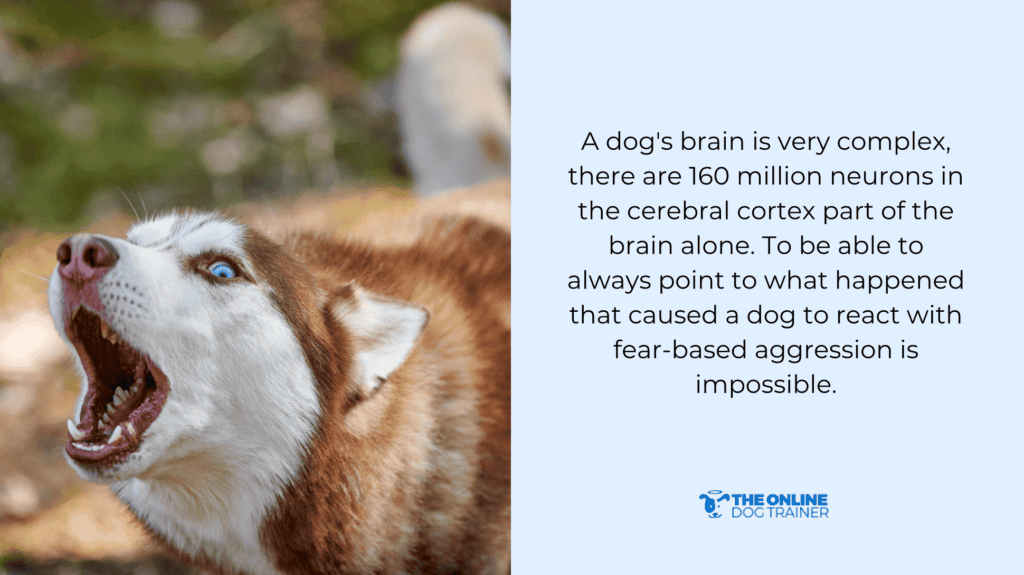
It's important to point out that this sort of fear-based aggression can arise for absolutely no reason.
A dog doesn't have to be abused or fear their owner is in danger to suddenly experience fear-based aggression.
So why does it happen? We may never know…
A dog's brain is very complex! There are 160 million neurons in the cerebral cortex part of the brain alone. To be able to always point to what happened that caused a dog to react with fear-based aggression is impossible.
Think of it this way…
I have a sister who is deathly afraid of birds. My other sister fears spiders. Now, there was never any incident in which either of my sisters had a bad experience with birds or spiders…they simply have irrational phobias.
And the same irrational phobias can develop in dogs too.
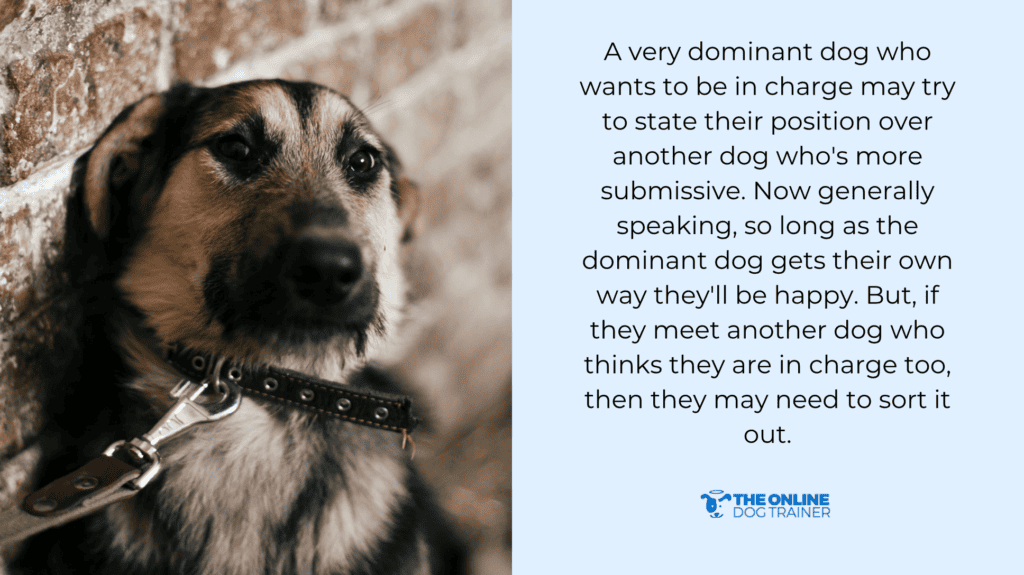
Sometimes the aggressive dog may be a little bit confident and proactively seek out other dogs.
Their tails are often up and their chests are puffed out! A generally fearful dog who finds that little bit of confidence for a few seconds may charge and run 100 meters to get to get to another dog.
Out of fear, they are looking to “get the first punch in” and actively go looking to do it.
On the flip side, some fearful dogs are not confident at all. Period. Their tails are down between their legs, and they won't leave their owner's side. They'll do anything to avoid you…they turn their heads and move away and try to avoid eye contact.
Less confident, fearful dogs will snap, bite or bark only if another dog or person gets too close.
Any type of fearful aggression or defensive aggression should be taken seriously. That's because any fear-based aggression can easily result in actual injury to either another dog or a human.
How do you fix it? We'll get to that in a minute after we talk about dominance-based aggression.
FREE REACTIVITY CLASS STOPS REACTIVITY IN UNDER A WEEK!Dominance-Based Aggression in Dogs
Aggression to establish dominance is completely different from fear-based aggression.
Dogs instinctually have a structure or hierarchy. And some dogs take this hierarchy more seriously than other dogs.
What is Dominance Aggression?
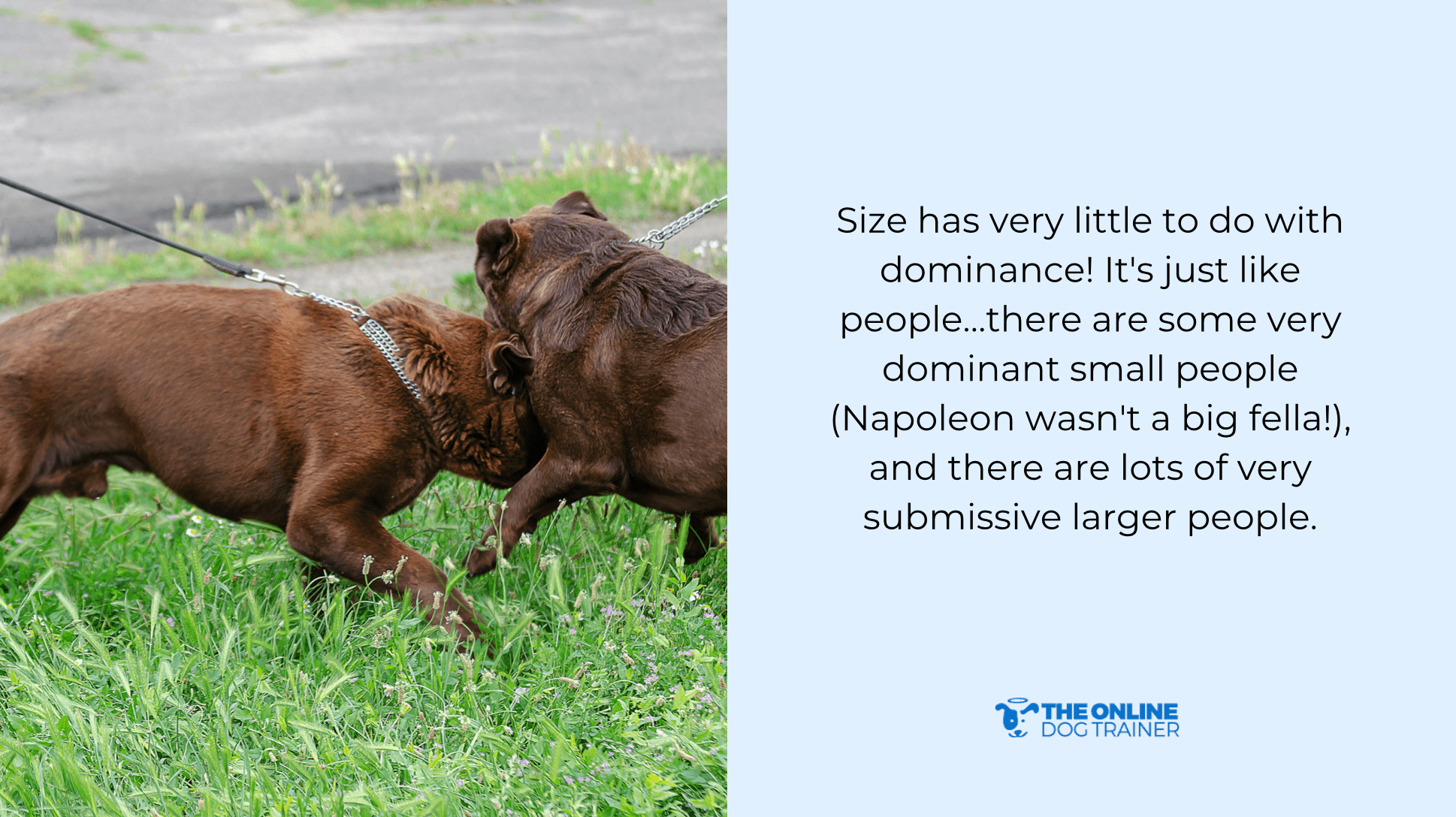
A very dominant dog who wants to be in charge may try to state their position over another dog who's more submissive.
Now generally speaking, so long as the dominant dog gets their own way they'll be happy. But, if they meet another dog who thinks they are in charge too, then they may need to sort it out. This is when you see a dog's territorial aggression increase.
Usually there's a couple of seconds of grizzle or an air snap, a dog growls, and it's all over. That's it. Done!
Now the good thing about this type of aggression is that it often doesn't result in injury between the dogs. This is because it's more of a test of strength than anything else–like two guys having an arm wrestling contest to find out who is stronger.
And so often that hierarchy is established with no aggression at all.
For example, if a dog slowly rolls over and lies on their back, submissively bearing their soft underbelly, it's all over, nice and peaceful.
It's when both dogs stand their ground that it can get slightly gnarly. While the more aggressive behavior is not pleasant to watch–may include some terrible noise or a bit of flying hair–it still rarely ends in serious injury to either dog.
Fun fact: Size has very little to do with a dog's behavior related to dominance! It's just like people…there are some very dominant small people (Napoleon wasn't a big fella!), and there are lots of very submissive larger people.
FREE ACCESS TO PROGRAM THAT CHANGED THE BEHAVIOR OF 100,000 DOGSThe Solution to Both Fear-Based and Dominance-Based Aggression
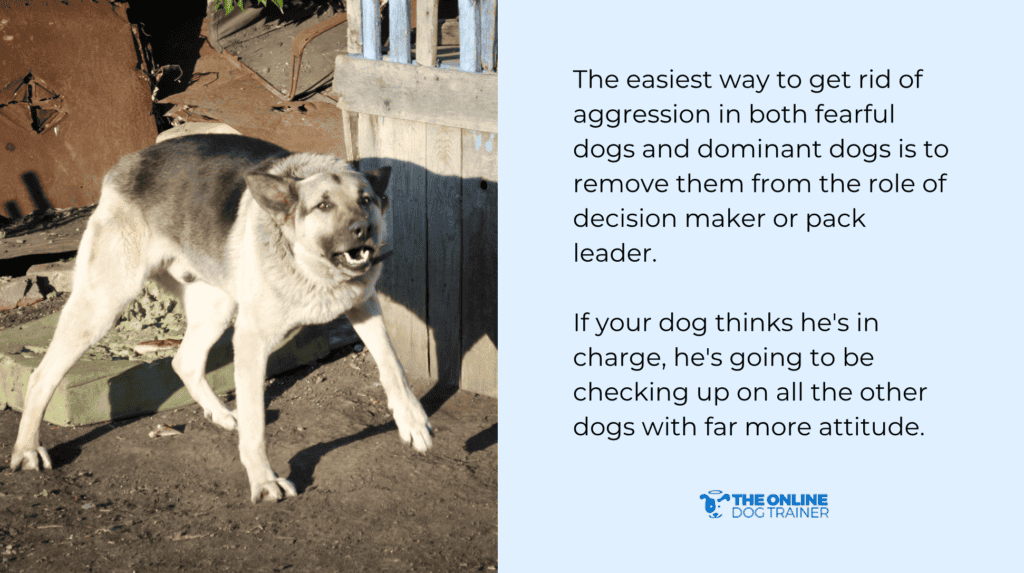
The easiest way to get rid of aggression in both fearful dogs and dominant dogs is to remove them from the role of decision maker or pack leader.
Think about it, with dominance-based aggression, if your dog thinks he's in charge, he's going to be checking up on all the other dogs with far more attitude.
I see it all the time where dogs are running around with chests out and tails up, checking the other dogs out in a very business like way, like it's part of their job. Remove that role and they will be far more chilled out.
What Happens To Dominance Issues Once Your Dog Sees You're in Charge
Analogy: I play soccer. I'm not the captain; my mate is. That means that before we kick off there are certain things my mate, Craig, has to do — go to center circle, shake hands, flip a coin, choose an end, chat to the ref–then he returns to his pack/team.
It's the same with a dog. When a dog thinks they are the alpha dog in charge, they feel there are certain things they have to do — one of them is go check out the other dogs and decide who's dominate and who's submissive.
On the flip side, if they know you're in charge, they can relax and trust that you will do any sizing up that needs to be done. There is no need to puff out the chest and go and check out all the other dogs.
The same goes for fear-based aggression. In order to get rid of this aggressive behaviour, your dog has to understand that they you are in charge and in control of what's going on.
So, like a human would turn to a leader in a difficult situation, it's important that your dog trusts you that you will protect them and have their best interests at heart.
This can take a bit of time, but then they'll follow your lead, and you'll be able to keep your dog's focus on you when it really matters.
JOIN THE FREE CLASS THAT'LL MAKE YOUR REACTIVE DOG FINALLY LISTEN TO YOU!How to Train a Dog Who Is Aggressive: What You Can Do When Training Aggressive Dogs
#1: Look out for environmental factors that could be triggering to your dog.
- Identify Specific Triggers: Is it certain people (men with hats, kids), other animals (dogs, cats), specific noises (fireworks, thunderstorms), or places (the vet's office, busy parks)? The more specific you can be, the better you can manage those triggers.
- Create a Safe Space: Ensure your dog has a den-like area where they feel secure and can retreat when feeling overwhelmed. This could be a crate, a quiet room, or even a specific corner of a room. This is important if you also have big, aggressive dogs like a german shepherd or a pittbull and you have small dogs you want to safeguard.
- Manage the Environment: If possible, control your dog's exposure to triggers. This might mean walking them at quieter times, using a barrier in the yard to prevent visual access to the street, or using white noise to muffle sounds.
#2: Learn how to read your dog's body language.
- Early Signs of Fear: Recognize subtle signs like yawning, lip licking, whale eye (showing the whites of their eyes), pacing, panting, tail tucking, or shaking. These indicate your dog is uncomfortable before they escalate to growling or snapping.
- Avoid Misinterpretation: Don't assume a wagging tail always means a happy dog. A fearful dog might wag their tail low and slowly while displaying other anxious behaviors.
- Respect Their Signals: If your dog shows signs of fear, give them space and remove them from the situation. Never force interaction.
#3: Help them move for mental stimulation.
- Appropriate Exercise: While physical exercise is important, for a fearful dog, focus on activities that build confidence and provide mental outlets.
- Enrichment Activities: Puzzle toys, scent work (hiding treats), and training games (like “find it”) can help tire them out mentally and build positive associations.
- Controlled Socialization: If fear is directed towards other dogs, carefully introduce them to calm, friendly dogs in a controlled setting, ensuring positive experiences.
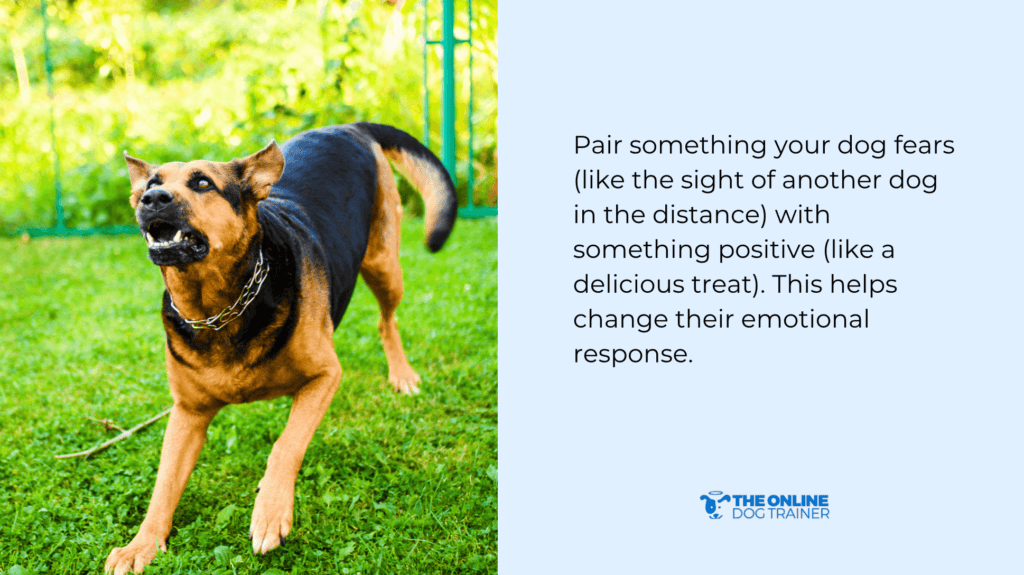
#4: Offer positive reinforcement.
- Reward Desired Behavior: Use high-value treats, praise, or toys to reward calm behavior, especially in situations that might normally trigger fear.
- Counter-Conditioning: Pair something your dog fears (like the sight of another dog in the distance) with something positive (like a delicious treat). This helps change their emotional response.
- Avoid Punishment: Never punish fear-based aggression. This will only increase their anxiety and worsen the problem.
#5: Consult Professional Dog Trainers
- Certified Behaviorist: Seek professional help from a dog trainer or a veterinary behaviorist experienced in fear aggression.
- Develop a Plan: They can assess your dog's specific needs and create a tailored training and behavior modification plan.
- Guidance and Support: A professional can provide valuable guidance, support, and troubleshoot any challenges you encounter during the training process.
Learn How to Establish Gentle Leadership In Your Dog Training with the Dog Calming Code
So, in a nutshell, whether your dog has fearful aggression or dominant aggression, I suggest spending less time training your dog and spend more time establishing yourself as a calm and gentle leader. It's as easy as that!
If you think you've discovered the cause of your dog's aggression and would like help getting your dog to calm down and look to you for direction when he becomes anxious or upset, I want you to check out my program called The Dog Calming Code.
This program has helped me train over 100,000 dogs–many of which have had various types of aggression issues.
Or, if you have a puppy I invite you to give my Puppy Coach training program a try instead!
I wish you the best!

~Doggy Dan 🙂







25 Responses
Helllo, we have a GSD who recently underwent a tonsillectomy. He has always gotten along with all our dogs. Since the surgery he is aggressive towards one of our other dogs who is also a GSD. They were besties prior to this surgery. We keep them separated with a baby gate, take them out at separate times. He cries and whines and wants to be with us, so we try and try again to let him with us. Each time he usually will attack the one dog. I feel so bad for the one being attacked as he is such a lovey dove and he hides a lot of times now. The one who is doing the attacking is also a lovey dove when this is not happening. We have not been able to identify anything that would trigger the situation and as I said this was not going on prior to his surgery. Do you have any suggestions for how to correct this? It’s very frustrating for the whole household. Thank you.
Check out the free webinar, you’ll love it!
The Reactivity Webinar happens weekly on Wednesday and Sunday at 3pm EST (USA time). The link for the webinar is here, and you can choose this week or the following week: https://theonlinedogtrainer.com/reactivity-ewebinar-register/
If you register, you’ll get the recording via email after the webinar
This article really breaks down the difference between fear-based and dominance-based aggression in a clear, practical way. I appreciate the emphasis on calm leadership and building trust with our dogs—it’s a game-changer!
Hi Dan, good article. But okay if I know I have a dominant dog, so how do I go about correcting dominance aggressive behavior to other dogs at the dog park?
I adopted a 5 year old Canaan mix nine months ago and I have always known she was dominant from the moment I got her, but yesterday was the first time she started exhibiting some behaviors I didn’t like, specifically mounting, but unrelated she has definitely spent a lot of energy establishing herself as queen of the park. Yesterday there was a fight and I didn’t see what had happened but since it was a dog she was previously trying to mount and I had stopped a few times, I suspect I hadn’t been as careful and observant as I should have been and that my dog’s behavior triggered a fear aggressive response from the other dog, leading to a fight. Now of course I am the newbie at the park so half the people just blamed my dog. Anyway, I can’t do anything about them watching their dogs but I still want to stop my dog’s dominance aggressive behavior now before it gets out of hand. Any specific advice, please?
Hi Roma, great question!
There are a range of behaviours that dogs use that are designed to establish rank or pecking order with other dogs. However, to strange dogs these can often be intimidating and they can get to a point where of the action continues they will respond telling the dog to ‘back off!’ Jumping on, humping and pushy/intimidating behaviour are the most common ones and so if you see your dog doing this to another dog then calmly intervening is advised. I usually just gently take hold of the dog’s collar and move them away from the other dog a little, wait for their excitement level to reduce and if they do then I release them again. If they return to continue the behaviour I may give the dog one last separation but then they lose the privilege of their freedom if they fail to use some self-control. There is no need to tell the dog off or make a big fuss, just let your calm and consistent action speak louder than words here.
There is a lot more you can do to show your dog that this behaviour is not desirable. My website TheOnlineDogTrainer.com shows you very clearly how to achieve this…maybe take a quick look…its a $1 trial for 3 days…all the best Doggy Dan
Hi, Dan,
Where to begin! We got a Great Dane puppy from a breeder that got very sick the week after we got him. Turns out that he had parvo. Awful, awful disease. After much time and round the clock efforts, including me giving him IV’s for fluid at home, he is now 7 months old (today!). The problem with Marley is that he bites me. When he was a puppy and teething, people said that’s what happens! They chew on you! Now, Marley is 7 months old and weighs about 70 lbs. His big teeth crush my arm/hands as opposed to drawing blood with those razor sharp baby teeth.
I believe that he has fear from me giving him those IV’s and doesn’t see me as a pack leader (which I intend to fix with your help)
I have hired a trainer to come to the house and help me, but I feel like I may have put the cart before the horse with that.
I need help. I have been bitten every day, many times a day, since November. I think that my dog spends too much time in his crate because I refuse to be chewed on.
I’ve tried yelping when he bites, spraying him with vinegar water, putting him in time out, and nothing helps.
I love him, but not his behavior. My arms are covered with bruises. I just want to have a behaved dog that is at peace and not on 100 all the time. I want to do right by him so that he feels safe and happy.
I’m desperate . Any help is much appreciated. Thanks.
Hi Cheri,
there are many reasons why dogs mouth/bite their owners and at 7 months of age, and also being a larger dog, the behaviour really needs to be brought under control as soon as possible. It’s not clear from your post what the scenarios are where he bites you…sometimes it can be attention seeking and sometimes it can be a result of having their personal space invaded. My advice is that if you want to give him a pat/fuss then invite him to you rather than approach him to do so. This may seem like only a small detail but to dogs it’s an important one. If he bites you/mouths for attention then telling him off or making a big fuss can be really counterproductive. I’m not saying to just ignore his behaviour, rather to use calm and consistent actions rather than words. If he bites you then placing him in a room on his own for 5-10 minutes will show him that the behaviour will not gain attention AND if he does it he will actually end up all alone. This will encourage him to start to use some self-control. As I said previously, the ley is to identify why he is biting you so you can then respond correctly to overcome the behaviour. My website TheOnlineDogTrainer.com shows you very clearly how to achieve this…maybe take a quick look…its a $1 trial for 3 days…all the best Doggy Dan
Hello,
I wonder if you could help with a problem we have. I have a new partner who regularly visits my home and my dog, E. He has a dog at home, T. we have now introduced E & T at T’s house and on walks but T is very aggressive towards E. I am assuming that he has been smelling E on my partner for a while and is now protecting his territory. We have tried rewarding good behaviour – they can go for hours without problems (even sitting on the sofa together) then T gets grumpy and aggressive. (they have been fed together OK and have even spent the night together OK). Any suggestions would be greatly received. thank you
Hi,
Adding a new dog to the family dynamic is certainly a time where both dogs will seek to work out a pecking order with each other. Provided that they are doing this respectfully then there is no need to intervene too much BUT in your case it sounds like you will need to be a little more involved in showing both dogs how you expect them to behave toward one another. It sounds like you have some really great strategies in place but there is certainly more that can be done to help E & T learn to live harmoniously together. My website TheOnlineDogTrainer.com shows you very clearly how to achieve this…maybe take a quick look…its a $1 trial for 3 days…all the best Doggy Dan
I have a 5 year old German Shepherd/Akita. I got him at 20 months and his earlier owner was a jogger. So at first he took no notice of anything when walking not even to stop and pee. Took him to dog play group and he did well up until a he and a Rottweiler got into a fight. The lady who ran the group told me I needed to get an e-collar for him, then she would allow him in group and she could control him. I did get the collar but decided it was too hash. I wouldn’t put on my child so why my dog? Now when he see people get pants loudly and will jump at them. When people talk to him, make eye contact he will bark at them and get mouthy. Once he knows someone all is OK.
Dogs, he is so excited just to get to them. I’m not sure what would happen.
How do I help Rush as we would both like to have a nice walk with out all the excitement?
Hi Kim,
It is really common for a dog’s behaviour to change towards other dogs after they have been involved in a fight or negative encounter. The reason it happens is that the dog now has very good reason to view all other dogs, and even people/bikes/cars, as a potential threat to their safety. Their behaviour is generally a sign of fear.
When meeting strangers my advice would be to ask them to delay saying ‘hi’ until he relaxes, this includes eye contact, and keep him on a shorter leash besides you. Have a quick chat to the person and if your dog seems more relaxed then you can have the person call him to them to receive a pat. I always avoid allowing strangers to approach my dogs to pat them as that stranger is invading their personal space and that can lead to them feeling unsure. If your dog is comfortable then he will go to them but if he would normally then jump at them, I would have you hold him gently buy the collar as he receives that pat. This way you can manage his behaviour and move him away if he starts to get too excited. Make sure you remain calm yourself and avoid telling him off for his behaviour, simply move him away and end the pat/fuss.
My website TheOnlineDogTrainer.com shows you very clearly how to achieve calm behaviour on the walk…maybe take a quick look…its a $1 trial for 3 days…all the best Doggy Dan
Hi Dan,
I have a papillon and a german shepherd. The papillon always tries to attach the german shepherd who just stands there and takes it. The german sheperd does hover over the papillon which just agrevates the situation. I try to keep them separated, but sometimes it is just impossible. Do you have any suggestions?
Hi Cherry. Juts be aware that your German Shepherd may be space invading here, leading your Papillon to feel unsettled. Have you tried calling your Shepherd away when they invade the space of your Papillon? This just allows your Papillon to feel that she doesn’t have to be the one to lay out the ground rules. If your Shepherd refuses to move away or returns to repeat the behaviour then you can consider removing your Shepherd from the room for a few minutes as a signal that they will be removed if they continue to space invade. No need to tell your Shepherd off just respond calmly and consistently and they will get the idea.
We do also cover this issue on my website TheOnlineDogTrainer.com …maybe take a quick look…its a $1 trial for 3 days…all the best Doggy Dan
Hi Dan,
I have been looking at your online program, but think I would benefit in direct advice quickly. The reason – I have just taken on a rescue dog, a German shephard called Maddie that has been labelled Menacing by the council, and was going to be put down by them as they would not release her to the previous owner. Knowing the dog, that has had been abused and neglected and not correctly socialized I wish to give her a chance. I have 14 days to appeal the ‘label’.
So wish to know how to work through this and socialise her. The main behaviour is aggression to small dogs and frantic need to attack cats. She can be around goats, hens and bigger dogs, but the other two drive her crazy.
Is it possible to organise a consult or working session early this week and how much would it cost?
The thought of her being put down because of neglect by humans is madness for such a beautiful creature.
I live in Leigh, north of Warkworth but could drive to Auckland to meet.
Look forward to hearing from you
Regards
Tina
Hi Tina,
love to help out with this, please contact me directly ASAP cheers Dan
how do i let my chawauwa terrior mix dominance aggressive dog realize that I’m the pack leader???
Hi Teresa, my training program TheOnlineDogTrainer.com covers it all off. It is $1 for a 3 day trial. You can cancel or stay on during the trail…Hope that helps…Dan
I really enjoy your teaching method .One doesn’t need to absorb too many facts, so one is able then to concentrate on delivering the information while having full attention given to the animal concerned. GREAT!
Hi Elaine, so glad you like it! I often say that dogs really aren’t the complicated animals that we make them out to be. If you give them the correct information then they can be the calm and happy dogs we all want them to be. Best, Dan
Common sense is not so common, thanks for the great tips. You are so right in that too many dogs end up given away because of aggression. A tragedy.
Hi Sylvie, yes I do often find myself reminding owners to use common sense when interacting with dogs, whether that is their own dog or someone else’s. My aim is to help everyone avoid really basic and common mistakes that all too often dogs end up paying for. Best, Dan
I have an Staffordshire Bull terrier that is 2 and was rescued by me at about 6mos, he was very aggressive then and still is. I can not trust him with cats and other dogs that do not live in the house with him. He goes nuts in the car, but loves to ride. His favorite thing to do is to play with tennis balls and loves to swim. He weighs 75 lbs. I can not trust him around other dogs or cats. How do I determine why he is aggressive.
Hi Victoria,
Basically your dog by instinct is loyal to his pack/family alone, that includes cats, and he doesn’t necessarily feel the same towards strange dogs and cats who aren’t a part of his pack/family. Dogs who behave aggressively in this way are generally motivated by the fact they thing it is their job to protect their pack. So to change this behaviour the solution is to show your dog that he is in fact not the decision maker/leader of the pack, you are. Once you remove this job from him he will start to look to you for direction on how to behave towards other dogs and cats. My membership website deals with this issue and shows owners how to effectively overcome this behaviour. Best, Dan
HI Doggy Dan,
Thanks for this subject of dog aggression. Our next door neighbor’s got a dog from a Labrador rescue center in Texas. They thought they were getting a 6 1/2 week old lab. mix. As it turned out with DNA testing, she has no lab in her.
There was just no puppy in this dog from day one. They took her to obedience training and she did pretty well with that but had “issues” with some of the other dogs there even though the instructor had a rule of no attention to other dogs or their owners. We used to be invite her to come over for play with our Australian Shepherd in our fenced back yard but her behavior became so dominant, and then aggressive, that I had to tell them that we had to protect our own dog and she was no longer welcome. It wasn’t long before most in the neighborhood did not like nor trust this dog. The next door neighbor’s have an underground electric fence on their property. They also have, besides that instrument on her collar, a bark shock collar. Our fence is a chain-link fence and when I go out to play with our dog, the dog next door goes nuts; growling and lundging at the chain link and biting the fence. I’m afraid she is going to break her teeth! She and I get along fine and I believe that is because I spent time with her as a new dog and because I ignore her and her other behaviors when I’m playing with our dog in the back yard or when I’m on her property until she calms down and I call her to me. But other people and dogs cannot get near her. She will come up to be petted(?) but moves away rapidly when they reach out to pet her; hackles and taIl raised and growling. Our neighbor’s were told by the place where they kenneled her while on vacation that she was a dog with many mental issues and that they could not put her with other dogs for play time. I have suggested the long lead to them in the back yard and a quick but gentle time out but they have not followed up on that suggestion. It is irritating to both my husband and I that we cannot go out and play with our dog without Lily attacking the fence. We take our dog to a large field to run him daily because his breed needs lots of activity but it would sure be nice to throw the ball for him down a steep hill in our own back yard without the neighbor’s dog bouncing back and forth off our fence. I am concerned about my dogs safety should she ever jump the underground electric fence on part of her property and get to our dog. Do you have any suggestions of what I might do to help this dog feel safe in her own back yard while we are out there? She runs off any dogs who are not leashed (they are supposed to be) in the neiborhood who come onto her property but so far has not jumped the wire.
Hi Susan,
I really do feel for this dog as it is a very stressful life when you feel you are the protector of your family and you are panicking with that responsibility. Aggression in many cases is fear driven and an over-reaction from a dog who is panicking. All dogs view strange dogs and people as potential dangers, even though we know we will not harm them, a dog is directed by it’s instinct to survive. Of course I’m not saying that every dog acts aggressively out of this fear of ‘danger’, there are some dogs who appear over-friendly with strangers and this behaviour is motivated apparent for the same reason. It simply comes down to a dog’s personality, past experience and sense of responsibility. The behaviour can be changed in the majority of cases, the dog just needs the right information from their owner.
As far as what you can do to ease this dogs aggression when you are in your yard, you are already doing. Paying no attention to the dog shows it that you are not threat. Speaking to him when he is panicking, no matter how sweetly, would only make matters worse. I would say nothing, avoid eye contact and initially stay further from the fence until he calms down.
When a dog’s sense of responsibility is so great things like e-collars or shock collars do not work and in fact they can reinforce the behaviour by creating a negative physical sensation as well. It’s the reason we don’t advise the use of them to solve any behavioural issue. You need to deal with the root cause of the issue in order to solve it effectively, and this is what we teach owners to do on my membership website.
Thanks for your post….All the best, Doggy Dan